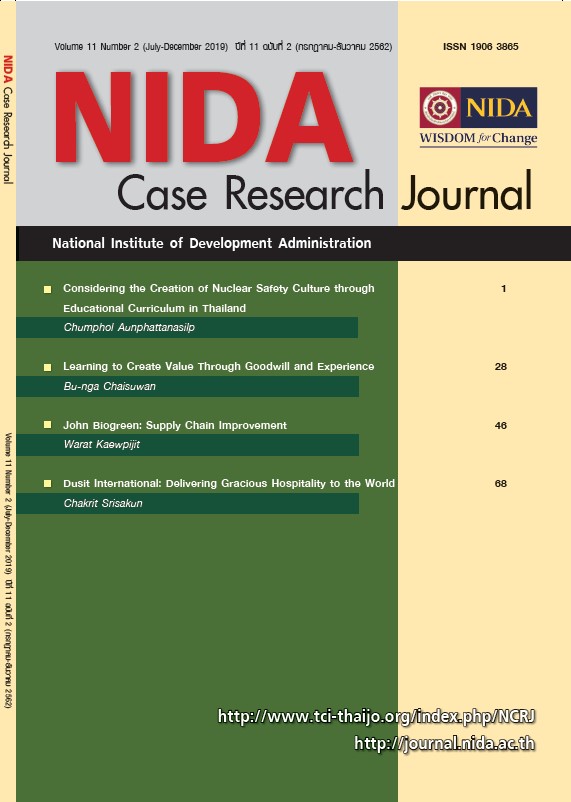พิเคราะห์การสร้างวัฒนธรรมความปลอดภัยทางนิวเคลียร์ ผ่านหลักสูตรการศึกษาในประเทศไทย
Main Article Content
บทคัดย่อ
บทความชิ้นนี้มีวัตถุประสงค์ที่จะนำเสนอการจัดการความรู้ทางด้านนิวเคลียร์ก่อนการก่อสร้างโรงไฟฟ้านิวเคลียร์ โดยเลือกประเทศไทยเป็นกรณีศึกษา ภายใต้การกลับมาของกระแสความนิยมต่อพลังงานนิวเคลียร์ในทวีปเอเชีย รัฐบาลไทยในช่วงทศวรรษที่ 2550ได้ตระเตรียมชุดนโยบาย โครงสร้างทางกฎหมาย และหน่วยงานต่างๆ เพื่อก่อให้เกิดการก่อสร้างโรงไฟฟ้านิวเคลียร์ ข้อถกเถียงเชิงนโยบายที่เกี่ยวข้องกับโรงไฟฟ้านิวเคลียร์มักวางอยู่บนหลักคิดเรื่องผลประโยชน์ทางเศรษฐกิจ ราคาค่าไฟฟ้า ความมั่นคงทางพลังงาน และความกังวลเรื่องอุบัติภัยจากโรงไฟฟ้านิวเคลียร์ เพื่อที่จะขยายบทสนทนาทางนโยบายนิวเคลียร์ให้ก้าวไปไกลกว่าประเด็นเดิมๆ บทความชิ้นนี้มีเป้าหมายที่จะตรวจสอบว่า ทำอย่างไรที่แนวคิดวัฒนธรรมความปลอดภัยทางนิวเคลียร์ในฐานะที่เป็นแนวคิดระดับโลก ซึ่งได้รับการสนับสนุนจากทบวงการพลังงานปรมาณูระหว่างประเทศ จะถูกผนวกรวมเข้าไปในข้อถกเถียงเชิงนโยบาย งานวิจัยที่ผ่านมาระบุว่า หลักสูตรการเรียนการสอนเกี่ยวกับนิวเคลียร์ถือเป็นเครื่องมือสำคัญที่ให้การศึกษาแก่ประชาชนและปรับเปลี่ยนการรับรู้ และองค์ความรู้ของประชาชนที่มีต่อโรงไฟฟ้านิวเคลียร์
จากข้อแนะนำที่เป็นประโยชน์ของงานวิจัยที่ผ่านมา บทความชิ้นนี้จึงศึกษาเปรียบเทียบหลักสูตรการเรียนการสอนเกี่ยวกับนิวเคลียร์ในระดับมัธยมศึกษาและอุดมศึกษาจากหลายประเทศรวมถึงประเทศไทย เพื่อที่จะประเมินว่า ผู้พัฒนาหลักสูตรการเรียนการสอนเกี่ยวกับนิวเคลียร์ได้ผสมผสานแนวคิดวัฒนธรรมความปลอดภัยทางนิวเคลียร์เข้าไปในการออกแบบหลักสูตรหรือไม่ ข้อค้นพบจากการวิจัยชี้ให้เห็นว่า หลักสูตรการเรียนการสอนเกี่ยวกับนิวเคลียร์จากประเทศที่เป็นกรณีศึกษารวมทั้งประเทศไทยนั้น ผสมผสานแนวคิดวัฒนธรรมความปลอดภัยทางนิวเคลียร์น้อยมาก บทความชิ้นนี้จึงเสนอชุดของหัวข้อที่เป็นทางเลือก ซึ่งบรรจุแนวคิดวัฒนธรรมความปลอดภัยทางนิวเคลียร์ในฐานะข้อเสนอแนะเพื่อปรับปรุงการออกแบบหลักสูตรการเรียนการสอนเกี่ยวกับนิวเคลียร์ องค์ความรู้ที่เกี่ยวข้องกับวัฒนธรรมความปลอดภัยทางนิวเคลียร์จะช่วยเพิ่มการรับรู้ของประชาชนเพื่อจะเข้าใจความเชื่อมโยงที่กว้างขวางขึ้นระหว่างนิวเคลียร์และประเด็นทางสังคมอื่นๆ ซึ่งจะเป็นเงื่อนไขทางความคิดสำหรับการกำหนดอนาคตของโรงไฟฟ้านิวเคลียร์
Article Details
References
Atomic Energy for Peace Act, 1961.
Barabas, R de C. and Sabundjian, G. (2013, November 24-29). Nuclear Energy Education Scenario around the World. Paper presented at the 2013 International Nuclear Atlantic Conference, Brazilian Association of Nuclear Energy, Recife.
Behling, N.; William, M. C.; Managi, S. (2019). “Regulating Japan’s Nuclear Power Industry to Achieve Zero-accidents.” Energy Policy, 127: 308-319.
Bernido, C. C. (2007). Nuclear Science and Technology in Higher Education in the Philippines. Vienna: International Atomic Energy Agency.
BP p.l.c. (2019). BP Statistical Review of World Energy 2019. London: BP p.l.c.
Choi, Y.; Kim, J.; and Han, E. (2017). Education Effects of Operating a Model School for Korea Elementary, Middle and High School Student to Understand Nuclear Power. TEM Journal, 6 (2), 286-293.
Committee on Nuclear Energy for Peace. (2017). Policy and Strategic Plan for Development of Nuclear Energy. Bangkok: Ministry of Science and Technology.
Committee on Nuclear Energy for Peace. (2017). Action Plan on Policy and Strategic Plan for Development of Nuclear Energy. Bangkok: Office of Atomics for Peace, Ministry of Science and Technology.
Cooper, D. (2002). “Safety Culture: A Model for Understanding and Quantifying a Difficult Concept.” Professional Safety, June 2002: pp. 30-36.
Energy Policy and Planning Office. (2015). Thailand Power Development Plan 2015-2036. Bangkok: Energy Policy and Planning Office, Ministry of Energy.
Faculty of Engineering, Chulalongkorn University. (2018). Bachelor Course in Engineering in Nuclear Radiological Engineering. Retrieved February 3, 2020, from Faculty of Engineering, Chulalongkorn University Website http://www.ne.eng.chula.ac.th/wp/index. php/programs/b-eng/
Hewamanna, R. (2007). Present Status of Nuclear Science Education and Training in Sri Lanka. Vienna: International Atomic Energy Agency.
Hong, S.; Brook, B. W. (2018). “A Nuclear-to-gas Transition in South Korea: Is It Environmentally Friendly or Economically Viable?” Energy Policy, 112: 67-73.
Institute for the Promotion of Teaching Science and Technology, Ministry of Education. (2010). Handbook for Teaching Physics in High School Program. Bangkok: Office of the Welfare Promotion Commission for Technology and Educational Personnel.
Institute for the Promotion of Teaching Science and Technology, Ministry of Education. (2012). Physics Volume 5. Bangkok: Office of the Welfare Promotion Commission for Technology and Educational Personnel.
International Atomic Energy Agency. (1991). Safety Culture. Vienna: International Atomic Energy Agency.
International Nuclear Safety Advisory Group. (1992). The Chernobyl Accident: Updating of INSAG-1. Vienna: International Atomic Energy Agency.
International Atomic Energy Agency. (1998). Developing Safety Culture in Nuclear Activities: Practical Suggestions to Assist Progress. Vienna: International Atomic Energy Agency.
International Atomic Energy Agency. (2005). Safety Culture in the Maintenance of Nuclear Power Plants. Vienna: International Atomic Energy Agency.
International Atomic Energy Agency. (2011). Status and Trends in Nuclear Education. Vienna: International Atomic Energy Agency.
International Atomic Energy Agency. (2019). Nuclear Power Reactors in the World. Vienna: International Atomic Energy Agency.
Jho, H.; Yoon, H. G.; Kim, M. (2014). The Relationship of Science Knowledge, Attitude, and Decision Making on Socio-scientific Issues: The Case Study of Students’ Debates on a Nuclear Power Plant in Korea. Science and Education, 23, 1131-1151.
Karsono, E. (2005, October 26-28). Nuclear Science and Technology Education and Training in Indonesia. Paper presented at Technical Meeting on Asian Network for Higher Education in Nuclear Technology, Hanoi, Vietnam.
Kim, C. and Goto, S. (2019). The Issue of Nuclear Energy in K-12 Education: Cases of National Curriculum in Japan and Korea. Japanese Journal of Environmental Education, 28 (4), 68-76.
Korea Atomic Energy Research Institute. (2003). Report of the Consultancy Meeting on Asian Network for Higher Education in Nuclear Technology. Daejeon: Korea Atomic Energy Research Institute.
Matsuo, Y.; Nei, H. (2019). “An Analysis of the Historical Trends in Nuclear Power Plant Construction Costs: The Japanese Experience.” Energy Policy, 124: 180-198.
Moray, N. (2001). Culture and National Factors in Nuclear Safety. In B. Wilpert & N. Itoigawa (Eds.), Safety Culture in Nuclear Power Operation (pp. 38-61). New York: Taylor& Francis.
Mwangi, E. and Gatari, M. (2018, May 17-18). Curriculum Development of a Nuclear Engineering Course for Human Resources Enhancement in the Kenya Nuclear Energy Program. Paper presented at the Transactions of the Korean Nuclear Society Spring Meeting, Jeju, Korea.
Nuclear Energy Agency, Organization for Economic Co-operation and Development (OECD). (2016). The Safety Culture of an Effective Nuclear Regulatory Body. Paris: The OECD Nuclear Energy Agency.
Prachachat, Thailand Promotes Nuclear Power Plants: Public-Private-Academic Groups Support the Investment of Nuclear Power Plants. July 17, 2012.
Roh, S.; Lee, J. W. (2018). “Differentiated Effects of Risk Perception Dimension in Nuclear Power Acceptance in South Korea.” Energy Policy, 122: 727-735.
Royal Decree on Thailand Institute of Nuclear Technology, 2006.
Slugen, V. (2005). Education in Nuclear Engineering in Slovakia. Trnava: Research Institute of Nuclear Power Plant.
Thairat, Supporting Nuclear Power Plants. October 6, 2009.
Thairat, EGAT Proposes Nuclear Power Plants. December 11, 2009.
Thailand Power Development Plan, 2010.
Thairat, Ubon Rachatani People Gather to Oppose Nuclear Power Plants. January 21, 2011.
Wang, S.; Wang, J.; Lin S. (2019). “Public Perception and Acceptance of Nuclear Energy In China: The Role of Public Knowledge, Perceived Benefit, Perceived Risk, and Public Engagement.” Energy Policy, 126: 352-360.
Wongkontan, D. (2011). Nuclear Power Plant: Feasibility Study and Socio-cultural Impacts from Power Plant Constructions in Thailand. Doctoral dissertation, Mahasarakham University.
Wilpert, B. (2001). The Relevence of Safety Culture for Nuclear Power Operations. In B.
Wilpert & N. Itoigawa (Eds.), Safety Culture in Nuclear Power Operation (pp. 38-61). New York: Taylor& Francis.

